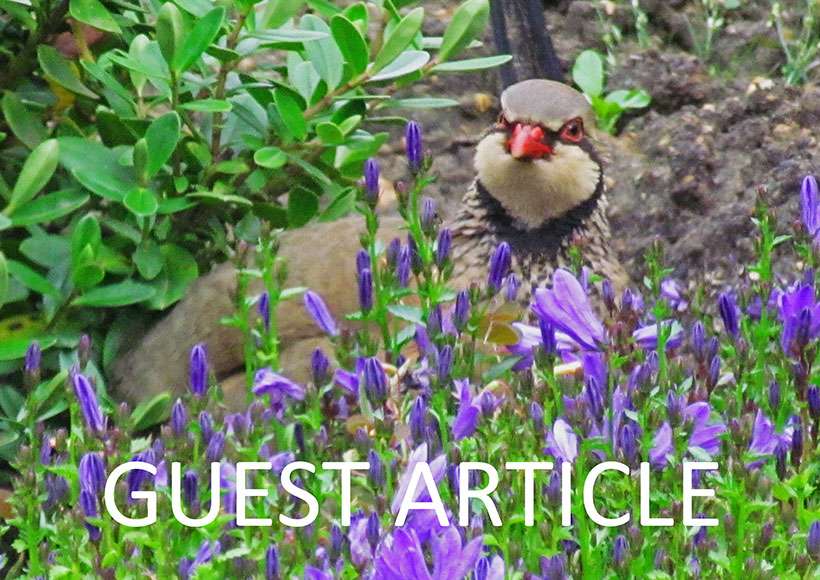Gardening for wildlife
25.1 January 2021
“When it comes to gardening for wildlife, it’s up to you: you can do a little or you can do a lot…but what important is to realize that…if everyone does their bit to help – it really can make a difference.”1
In this article our guest, Geoff, relates his experiences in creating his own wildlife garden.

Our new wildlife garden
25.2 January 2021
We moved into our new super-insulated ‘Eco- house’ in the Surrey Hills in May 2017. The two-acre site was formally a plant and tree nursery which had fallen into disuse and had been lying empty for many years. The developers had cleared most of the scrubland and taken out a lot of trees that had become over-grown and dangerous. Our new house was built into the hill and as a result over 1,000m3 of subsoil had been excavated to sink the house into the slope. The arising clay and sand had been spread over the remainder of the site.
So, we were delighted to move into a brand-new house, but the remainder of the plot was a real problem. In the summer, the clay became rock-hard, but as winter progressed the rainwater flowing down the hill turned it into a mud-bath. Even walking was nigh-on impossible.
We therefore sat down and roughed out a plan for the garden. The Planning Authority had stipulated that we were allowed a “formal garden” around the house itself, so we built a series of retaining walls to form lawn and planting areas. These were mainly built from gabions, which are wire baskets filled with stone from a local quarry. These were arranged to form terracing where the land sloped too steeply to plant or grass.
New locally sourced topsoil and compost were spread and planting commenced. This included a range of ornamental plants to fill the borders and mixed indigenous hedging around the boundaries.
But we still had the problem of the mud-bath on the remainder of the site.
We came up with a solution of installing some land drains and a building a wild-life pond. A mechanical digger excavated the rough pond shape and depth. I then levelled the perimeter and hand-finished the edges. The gradient of the pool ranges from shallow to about one meter deep. This is formed as shelves at various heights for different plants to occupy. I then installed the liner and concealed the perimeter with rocks left over from the gabion walls. It was left to gradually fill with water. When it was full, we planted various aquatic plants and water lilies.
The wild-live pond has been maturing nicely and we have spotted frogs and newts as well as a variety of dragonflies, damsel flies and skimmers. We have spent many happy moments watching them flit about above and below the water.
We then had to do something about the remainder of the site. It was gradually drying out due to the of the land drains but seeding in raw clay would not have been very successful. We therefore imported some low-fertile topsoil and spread a thin layer (about 50mm) over the clay. This provided a suitable medium to sow wildflower seed which we did in the spring of 2020. Unfortunately, a hot spell immediately followed the sowing, so we had to spend many hours watering to ensure our considerable investment in seed was not wasted – or eaten by birds!
Our efforts in watering the wildflower seeds were rewarded with a fantastic show of flowers throughout the summer. Many of the twenty-seven varieties flowered – particularly ox-eye daises, corn poppies and cornflowers which lasted well into autumn. After the seeds had dropped, I mowed the flower meadow and raked up the cuttings for composting. We are looking forward to next year, to see what blooms.
In 2019 we fulfilled a life-time’s ambition and built a swimming pool in an area next to the house. Again, we levelled the ground by building more stone gabion walls. We wanted to avoid the use of chemicals in the pool, so we opted for an Austrian natural pool system called Biotop. This is a system that circulates the pool water through a series of tanks containing a medium that removes the phosphorous to inhibit the growth of algae and open-cell foam blocks that become inhabited by ‘good’ bacteria that purify the water, much like a reed-bed. The result is a pool with natural water that requires little maintenance and is lovely to swim in.
This year we carried on with our planting plan, putting in more shrubs and trees as well as building a fruit cage for raspberries, blueberries, goose berries and blackcurrants. Also, figs, blackberries and loganberries have been planted against gabion walls to take advantage of the heat stored and reflected by the stone. We have also planted an orchard of apples, pears, cherries and plums.Three raised beds have also been built for growing vegetables which we start in a new greenhouse.
Bird life increased dramatically with the growth of our hedging and trees. I have built a dozen or more bird boxes which have nearly all been occupied. We also have feeders to help the birds through the cold weather when they need food most. The garden is now visited by numerous birds including great, coal and blue tits, starlings, blackbirds, thrushes, redwings, fieldfares, nuthatches, wrens, siskins, green and goldfinches, not to mention pheasants and woodpigeons hoovering up spilled seed under the feeders.
Also, we were delighted that a pair of partridges had nested in our shrub bed and produced seven babies. It seems three have survived as we regularly see them wondering around the meadow.
There is always some wildlife to see, even in winter and our efforts have been well-rewarded by watching the garden develop and enjoying our wild ‘visitors’, not to mention a multitude of insect life. With the sad news that bees are under threat it is especially rewarding to see the plants buzzing with them busily collecting pollen.
We are trying our best to “do our bit” by creating a wildlife garden and if everyone else did the same, even in very small gardens, then I am sure the magic of nature would start to thrive again.



